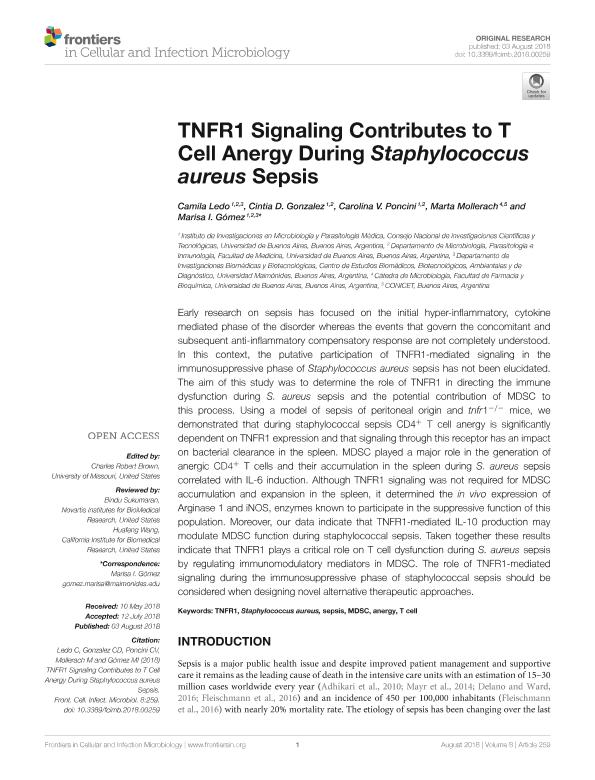Artículo
TNFR1 signaling contributes to T cell anergy during staphylococcus aureus sepsis
Ledo, Camila ; Gonzalez, Cintia Daniela
; Gonzalez, Cintia Daniela ; Poncini, Carolina Verónica
; Poncini, Carolina Verónica ; Mollerach, Marta Eugenia
; Mollerach, Marta Eugenia ; Gomez, Marisa Ines
; Gomez, Marisa Ines
 ; Gonzalez, Cintia Daniela
; Gonzalez, Cintia Daniela ; Poncini, Carolina Verónica
; Poncini, Carolina Verónica ; Mollerach, Marta Eugenia
; Mollerach, Marta Eugenia ; Gomez, Marisa Ines
; Gomez, Marisa Ines
Fecha de publicación:
08/2018
Editorial:
Frontiers Media SA
Revista:
Frontiers in Cellular and Infection Microbiology
e-ISSN:
2235-2988
Idioma:
Inglés
Tipo de recurso:
Artículo publicado
Clasificación temática:
Resumen
Early research on sepsis has focused on the initial hyper-inflammatory, cytokine mediated phase of the disorder whereas the events that govern the concomitant and subsequent anti-inflammatory compensatory response are not completely understood. In this context, the putative participation of TNFR1-mediated signaling in the immunosuppressive phase of Staphylococcus aureus sepsis has not been elucidated. The aim of this study was to determine the role of TNFR1 in directing the immune dysfunction during S. aureus sepsis and the potential contribution of MDSC to this process. Using a model of sepsis of peritoneal origin and tnfr1 -/- mice, we demonstrated that during staphylococcal sepsis CD4 + T cell anergy is significantly dependent on TNFR1 expression and that signaling through this receptor has an impact on bacterial clearance in the spleen. MDSC played a major role in the generation of anergic CD4 + T cells and their accumulation in the spleen during S. aureus sepsis correlated with IL-6 induction. Although TNFR1 signaling was not required for MDSC accumulation and expansion in the spleen, it determined the in vivo expression of Arginase 1 and iNOS, enzymes known to participate in the suppressive function of this population. Moreover, our data indicate that TNFR1-mediated IL-10 production may modulate MDSC function during staphylococcal sepsis. Taken together these results indicate that TNFR1 plays a critical role on T cell dysfunction during S. aureus sepsis by regulating immunomodulatory mediators in MDSC. The role of TNFR1-mediated signaling during the immunosuppressive phase of staphylococcal sepsis should be considered when designing novel alternative therapeutic approaches.
Archivos asociados
Licencia
Identificadores
Colecciones
Articulos(IMPAM)
Articulos de INSTITUTO DE INVESTIGACIONES EN MICROBIOLOGIA Y PARASITOLOGIA MEDICA
Articulos de INSTITUTO DE INVESTIGACIONES EN MICROBIOLOGIA Y PARASITOLOGIA MEDICA
Articulos(SEDE CENTRAL)
Articulos de SEDE CENTRAL
Articulos de SEDE CENTRAL
Citación
Ledo, Camila; Gonzalez, Cintia Daniela; Poncini, Carolina Verónica; Mollerach, Marta Eugenia; Gomez, Marisa Ines; TNFR1 signaling contributes to T cell anergy during staphylococcus aureus sepsis; Frontiers Media SA; Frontiers in Cellular and Infection Microbiology; 8; AUG; 8-2018; 1-12
Compartir
Altmétricas



